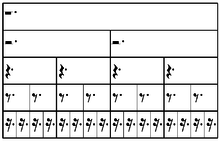Rest (music)
A rest is a musical notation sign that indicates the absence of a sound.
Each rest symbol and name corresponds with a particular note value for length, indicating how long the silence should last.
Description
Rests are intervals of silence in pieces of music, marked by symbols indicating the length of the pause. Each rest symbol and name corresponds with a particular note value, indicating how long the silence should last, generally as a multiplier of a measure or whole note.

| American English | British English | Multiplier | Symbol |
|---|---|---|---|
| Longa | Longa rest | 4 | |
| Double whole rest | Breve rest | 2 | |
| Whole rest | Semibreve rest | 1 | |
| Half rest | Minim rest | 1⁄2 | |
| Quarter rest | Crotchet rest | 1⁄4 | |
| Eighth rest | Quaver rest | 1⁄8 | |
| Sixteenth rest | Semiquaver rest | 1⁄16 | |
| Thirty-second rest | Demisemiquaver rest | 1⁄32 | |
| Sixty-fourth rest | Hemidemisemiquaver rest | 1⁄64 |
- The quarter (crotchet) rest


- The four-measure rest or longa rest are only used in long silent passages which are not divided into bars.
- The combination of rests used to mark a pause follows the same rules as for note values.[4]
One-bar rests
When an entire bar is devoid of notes, a whole (semibreve) rest is used, regardless of the actual time signature.[4] The only exceptions are for a 4
2 time signature (four half notes per bar), when a double whole rest is typically used for a bar's rest, and for time signatures shorter than 3
16, when a rest of the actual measure length would be used.[5] For a 4
2 bar rest, it is also common to use the whole rest instead of the double whole rest, so that a whole-bar rest for all time signatures starting from 3
16 is notated using a whole note rest.[5] Some published (usually earlier) music places the numeral "1" above the rest to confirm the extent of the rest.
Occasionally in manuscript autographs and facsimiles, bars without notes are sometimes left completely empty, possibly even without the staves.[6]
Multiple measure rests
 Fifteen bars' rest. A five-bar multirest has the number 5 written above, etc. |
 The old system for notating multirests (which is still in use today) which varies as the extent to which it is followed. |
In instrumental parts, rests of more than one bar in the same meter and key may be indicated with a multimeasure rest (British English: multiple bar rest), showing the number of bars of rest, as shown. Multimeasure rests of are usually drawn in one of two ways:
- As long, thick horizontal lines placed on the middle line of the staff, with serifs at both ends (see above middle picture)[1] or as thick diagonal lines placed between the second and fourth lines of the staff (but this method is much less used than the above method; although a small number of publishers use this method, it most commonly used casually in modern manuscripts),[5] regardless of how many bars' rests it represents;
- The former system of notating multirests (deriving from Baroque notation conventions that were adapted from the old mensural rest system dating from Medieval times) draws multirests according to the picture above right until a certain amount of bar rests is reached when multirests are then drawn to the first method. How long exactly must a multirest be until the above method is used is largely a matter of personal taste, most publishers use ten as the changing point, however bigger and smaller changing points are used, especially in earlier music.[1]
The number of whole-rest lengths for which the multimeasure rest lasts is indicated by a number printed above the musical staff (usually at the same size as the numerals in a time signature). If a meter or key change occurs during a multimeasure rest, the rest must be broken up as required for clarity, with the change of key and/or meter indicated between the rests. This also applies in the case of double barlines, which demarcate musical phrases or sections.
Dotted rests

A rest may also have a dot after it, increasing its duration by half, but this is less commonly used than with notes, except occasionally in modern music notated in compound meters such as 6
8 or 12
8. In these meters the long-standing convention has been to indicate one beat of rest as a quarter rest followed by an eighth rest (equivalent to three eighths). See: Anacrusis.
References
- History of Music Notation by C. Gorden, p. 93, copyright 1937.
- Examples of the older form are found in the work of English music publishers up to the 20th century, e.g., W. A. Mozart Requiem Mass, vocal score ed. W. T. Best, pub. London: Novello & Co. Ltd. 1879.
- Rudiments and Theory of Music Associated Board of the Royal Schools of Music, London 1958. I,33 and III,25. The former shows both forms without distinction, the latter the "old" form only. The book was the standard theory manual in the UK up until at least 1975. The "old" form was taught as a manuscript variant of the printed form.
- AB guide to music theory by E. Taylor, chapter 13/1, ISBN 978-1-85472-446-5
- Music Notation: A Manual of Modern Practice, second edition, by Gardner Read (Boston: Alyn and Bacon, 1969): 98. (Reprinted, New York: Taplinger Publishing Company, 1979).
- "Aesthetic Functions of Silence and Rests in Music", by Zofia Lissa, The Journal of Aesthetics and Art Criticism 22 (1964), no. 4: 443–54 doi:10.2307/427936.